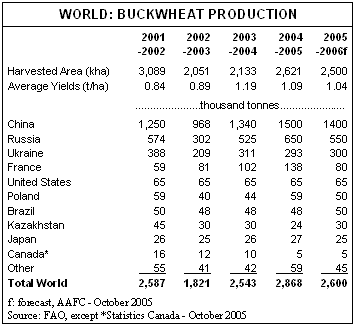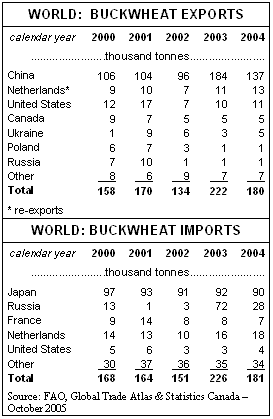Publications: Bi-weekly Bulletin
2005-10-07 | Volume 18 Number 18 | ISSN 1494-1805 | AAFC No. 2081/E
Buckwheat: Situation and Outlook
Buckwheat has many uses and is rated as one of the best sources of high biological value protein in the plant kingdom. In spite of its name, buckwheat is technically a fruit or a nut rather than a cereal grain. Although production in Canada has fallen to a low level, it is expected to increase over the longer term with the development of new varieties and increased consumption in Canada and the United States (US). This issue of the Bi-weekly Bulletin examines the situation and outlook for buckwheat.
World
World buckwheat production has been variable, but trending downwards during the past 10 years. China generally produces about 50% of the world's buckwheat, Russia about 20% and Ukraine about 15%.
World buckwheat exports averaged 173,000 tonnes per year during the 5 year period ending in 2004. China normally accounts for about 75% of the exports and Japan normally accounts for about 60% of the imports.
Canada
Production
Buckwheat is a broadleaf plant which grows best in well drained light to medium textured soils. Seeding normally takes place in the early part of June, after the risk of frost is gone. It matures in 80-90 days and makes an excellent rotation with cereal grains. It requires less nitrogen than cereal crops and is very efficient at removing phosphorus from the soil for its own needs. It also increases the phosphorus available for subsequent crops through its decomposing residue. Buckwheat is susceptible to stress during dry periods because the stomata stays open causing the plant to wilt. Weed control in buckwheat is a challenge since there are few herbicides available, particularly for broadleaf weeds. Since it is sown late, weeds are generally controlled with cultivation before seeding. Canadian buckwheat is normally harvested in September and early October.
Buckwheat production in Canada has been trending downwards during the past 20 years. Although buckwheat is produced from the Maritimes to Alberta, Manitoba normally accounts for more than half of Canadian production, with most of the rest produced in Ontario and Quebec.
Uses
Buckwheat is very nutritious and is used to make a wide range of products. The protein of buckwheat is comparable to animal-based proteins and is easily digestible. It has a well-balanced amino acid composition that is complementary to cereal grains, and buckwheat is high in iron, potassium, magnesium, sulfur and phosphorus, as well as vitamins B and P. Buckwheat is virtually fat free and is gluten free. An important by-product of buckwheat production is buckwheat honey, produced from nectar collected from buckwheat flowers by bees.
Buckwheat is milled into light or dark flour or processed into groats, the meat of the seed, and grits which are essentially cracked groats. Buckwheat flour is mixed with wheat flour to make noodles called Soba in Japan. Large seeded varieties, such as Koban and Koto, have a starch content about 7-8% higher than other varieties. In addition, the starch is softer, which makes the noodles chewy. This is a desirable trait. It also enables Japanese buckwheat millers to use up to 80% buckwheat in their noodle mixes compared to the usual blend of 50% buckwheat and 50% wheat flour. Buckwheat flour is also used for pancake mixtures or mixed with wheat flour for baking bread, rolls and cakes. As well, it is mixed with semolina to make pasta and is used in breakfast cereals, puffed snacks and stuffing. Since buckwheat does not contain gluten, it can be used to produce flour rich in high quality proteins, valuable for people with gluten sensitive enteropathy (celiac disease).
The groats and grits can be eaten plain, roasted or flavoured. Roasted groats and grits are called "kasha" in central and eastern Europe and are eaten as a porridge or used as a stuffing. The groats are also used to decorate bread and other baked goods. They are also used as a meat substitute or extender, for stuffing meats and vegetables, for mixing in soups and stews, and as a side dish. Buckwheat is also used in the manufacture of beer and ice cream.
Some light weight buckwheat seed is used for bird seed mixtures. The hull can be used to make pillows and heating pads.
Marketing
All of the buckwheat produced in Canada is sold on the open market to dealers. It is normally sold within a year after harvest, as it tends to lose its value when new crop starts to come into the market.
The Canadian Special Crops Association (CSCA) (www.specialcrops.mb.ca) establishes trade rules for domestic trade and serves as a forum for exporters, dealers and brokers involved in the industry of trading Canada's pulse and special crops, including buckwheat. The website includes a section where buyers can submit a request for prices and information on buckwheat uses, nutrition and health benefits.
The Canadian Grain Commission (CGC) administers quality control standards for buckwheat. For further information, or to access the Official Grain Grading Guide, please visit the CGC website: www.grainscanada.gc.ca
Domestic Use, Exports and Prices
There are several small processors of buckwheat in Canada, concentrating on milling buckwheat for flour, groats and grits, including for the organic food market. Some buckwheat is used in bird seed mixtures.
Japan and the US are the main markets for Canadian buckwheat. Canadian buckwheat imports are mainly from the US.
Average Canadian prices, over all grades and markets, have been relatively stable during the past ten years. Most of the buckwheat is grown under contract which guarantees the price for part, or all, of the production before seeding.
Outlook
2005-2006
World buckwheat production is forecast to decrease from the higher than trend production level in 2004-05.
Canadian production is forecast to remain stable, as a decrease in seeded area is offset by higher yields. However, supply is forecast to fall because of lower carry-in stocks, resulting in lower exports and domestic use. Carry-out stocks are expected to be negligible. The average price, over all grades and markets, is forecast to remain stable.
Canada: Longer Term
There are three main challenges which are limiting buckwheat production in Canada: (1) low yields, (2) lack of frost tolerance, and (3) the difficulty in controlling weeds. Work is underway in all three areas and improvements would increase the economic viability of buckwheat production.
Another method of improving the economic viability of buckwheat production is to increase demand and strengthen prices. This involves the development of varieties which are more desirable in Japan and by promoting the health benefits of eating buckwheat products to the consumers in North America.
The North American Buckwheat Promotion Committee is working "to develop and promote expanding use of buckwheat and its products by creating awareness of buckwheat's natural nutritional advantages".
Buckwheat has the potential to be used in pharmaceutical and nutraceutical products. It is high in lysine, an amino acid used in nutraceuticals. Buckwheat contains antioxidants: rutin, quercetin, hyperoside, catechin, epicatechin and proanthocyanidins.
Higher use in Canada and the US, as well as higher shipments to Japan and other overseas markets, would increase production, increase crop diversification and expand domestic processing.
by
While the Market Analysis Division assumes responsibility for all information contained in this bulletin, we wish to gratefully acknowledge input from the following: Manitoba Agriculture, Food and Rural Initiatives, Market and Industry Services Branch (AAFC)
|
|
||
| Date Modified: 2006-12-08 |
|
|
|
[ Français | Contact Us | Help | Search | Canada Site ] [ AAFC Online | Links | Newsroom | What's New | Site Index ] |
||



